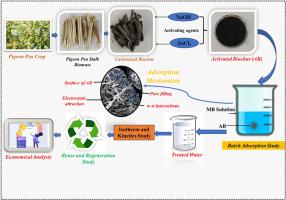高效吸附去除水中亚甲基蓝的木豆秸秆可持续活性生物炭的研制与优化
IF 5.8
2区 生物学
Q1 AGRICULTURAL ENGINEERING
引用次数: 0
摘要
本研究通过合成具有增强吸附性能的活性生物炭(AB)来研究鸽豌豆秸秆废物(PPSW)的增殖处理,以高效去除水溶液中的亚甲基蓝(MB)。该研究解决了农业废弃物处理和水污染问题,将PPSW转化为高价值的吸附剂。以氢氧化钠(NaOH)和氯化锌(ZnCl2)为活化剂合成了两种类型的AB,分别命名为NaOH/AB和ZnCl2/AB。采用L9正交设计优化合成工艺,考察了活化温度、活化时间、试剂碳比和搅拌速度4个关键参数。通过参数研究进一步考察了这些参数对MB吸附量(AC)和去除率(RE)的影响。采用方差分析进行统计优化和分析,验证各因素的显著性。利用先进的分析技术对合成的抗体进行了表征。对于NaOH/AB,最佳条件为活化温度40℃,活化时间12 h,试剂与碳比2:1,搅拌速度400 rpm。以ZnCl2/AB为例,在80°C, 12 h, 6:1的试剂与碳比,600 rpm搅拌速度下,最大AC为7.51 mg/g, RE为100%。结果表明,利用NaOH和ZnCl2制备的PPSW吸附物AB具有优异的吸附性能,可以有效地完全去除污染水中的MB。本文章由计算机程序翻译,如有差异,请以英文原文为准。

Development and optimization of sustainable activated biochar from waste pigeon pea stalks for efficient adsorptive removal of methylene blue from water
This study explores the valorization of pigeon pea stalk waste (PPSW) through the synthesis of activated biochar (AB) with enhanced adsorption properties for the efficient removal of methylene blue (MB) from aqueous solutions. Addressing both agricultural waste disposal and water pollution, the research converts PPSW into high value adsorbents. Two types of AB were synthesized using sodium hydroxide (NaOH) and zinc chloride (ZnCl2) as activating agents, designated as NaOH/AB and ZnCl2/AB, respectively. The synthesis process was optimized using an L9 orthogonal array design, evaluating four key parameters: activation temperature, activation time, reagent to carbon ratio, and stirring speed. The influence of these parameters on the adsorption capacity (AC) and removal efficiency (RE) of MB was further examined through parametric studies. Statistical optimization and analysis were performed using ANOVA to validate the significance of each factor. The synthesized ABs were characterized using advanced analytical techniques. For NaOH/AB, optimal conditions yielding 100 % RE were found to be an activation temperature of 40 °C, activation time of 12 h, reagent-to-carbon ratio of 2:1, and stirring speed of 400 rpm. In the case of ZnCl2/AB, maximum AC of 7.51 mg/g and 100 % RE were achieved at 80 °C, 12 h, a 6:1 reagent-to-carbon ratio, and 600 rpm stirring speed. The results confirm that AB derived from PPSW using NaOH and ZnCl2 exhibits excellent adsorption performance and is highly effective in the complete removal of MB from contaminated water.
求助全文
通过发布文献求助,成功后即可免费获取论文全文。
去求助
来源期刊

Biomass & Bioenergy
工程技术-能源与燃料
CiteScore
11.50
自引率
3.30%
发文量
258
审稿时长
60 days
期刊介绍:
Biomass & Bioenergy is an international journal publishing original research papers and short communications, review articles and case studies on biological resources, chemical and biological processes, and biomass products for new renewable sources of energy and materials.
The scope of the journal extends to the environmental, management and economic aspects of biomass and bioenergy.
Key areas covered by the journal:
• Biomass: sources, energy crop production processes, genetic improvements, composition. Please note that research on these biomass subjects must be linked directly to bioenergy generation.
• Biological Residues: residues/rests from agricultural production, forestry and plantations (palm, sugar etc), processing industries, and municipal sources (MSW). Papers on the use of biomass residues through innovative processes/technological novelty and/or consideration of feedstock/system sustainability (or unsustainability) are welcomed. However waste treatment processes and pollution control or mitigation which are only tangentially related to bioenergy are not in the scope of the journal, as they are more suited to publications in the environmental arena. Papers that describe conventional waste streams (ie well described in existing literature) that do not empirically address ''new'' added value from the process are not suitable for submission to the journal.
• Bioenergy Processes: fermentations, thermochemical conversions, liquid and gaseous fuels, and petrochemical substitutes
• Bioenergy Utilization: direct combustion, gasification, electricity production, chemical processes, and by-product remediation
• Biomass and the Environment: carbon cycle, the net energy efficiency of bioenergy systems, assessment of sustainability, and biodiversity issues.
 求助内容:
求助内容: 应助结果提醒方式:
应助结果提醒方式:


